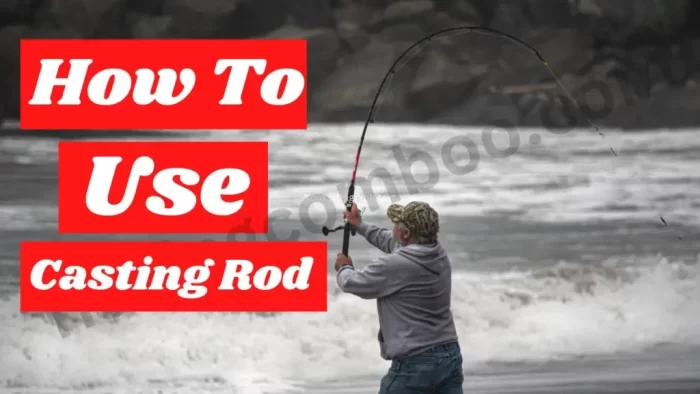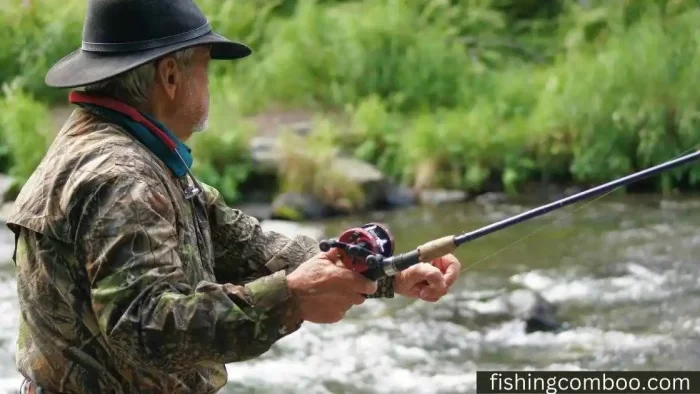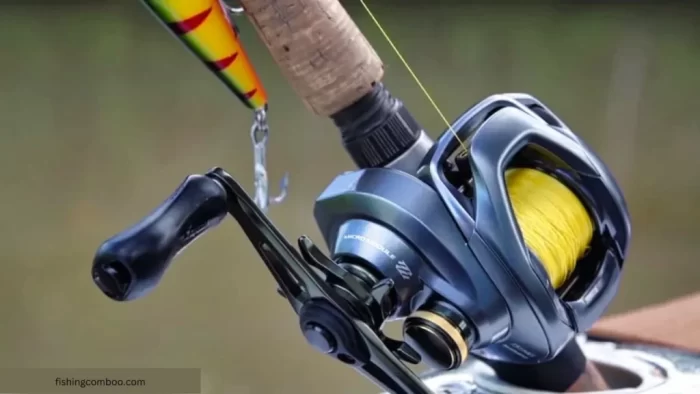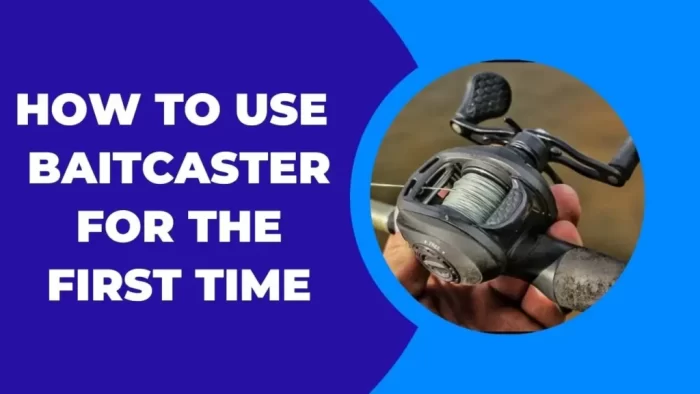
Are you a believer that baitcasters are difficult to use? Well, you’re not the only one. In fact, many people think the same way as you do, but the truth is, bait casters are quite easy to use once you get the hang of it.
Baitcasting is a great way to up your fishing game, but it can be tricky to learn if you’ve never used this before. Don’t worry – we’re here to help! In this guide, we’ll walk you through everything you need to know about how to use a baitcaster for the first time. By the end, you’ll be an expert at casting and reeling in like a pro!
What is a Baitcaster – Basics
Fishing reels designed to handle heavier lures and lines are known as baitcasters. Unlike spinning and spincast reels, baitcasters have a revolving spool that is mounted above the rod. This gives the angler more control over the casting process and allows them to fish with heavier lures and lines.
table of contents
- 1 How to Use a Baitcaster For the First Time – Step by Step
- 1.1 How to Set Up a Baitcaster Reel? 6 Easy Steps
- 1.2
- 1.3 How to Set Up a Baitcaster Rod?
- 1.4
- 1.5 How to Cast a Baitcaster – Tips and Tricks
- 2
- 3 Advantages of Using Baitcasters
- 4
- 5 Disadvantages of Using Baitcasters
- 6
- 7 My Review About Baitcasters
- 8
- 9 Frequently Asked Questions (FAq’s)
How to Use a Baitcaster For the First Time – Step by Step
As you know, there’re two important parts of baitcasters. The reel is the first part, and the rod is the second. In order to use a baitcaster, you need to connect these two parts. After that, you need to put your bait on the hook, and then you’re ready to fish.
So before we need to set up the reel and rod individually. Let’s take a look at how to make that happen.
How to Set Up a Baitcaster Reel? 6 Easy Steps
Setting up a bait caster reel is not difficult, but there are a few things you need to do to make sure everything is in working order. Here’s a quick guide on how to set up your baitcasting reel so you can start fishing like a pro!
1. Choosing the right baitcasting reel

The market is full of baitcaster reels, so it is important to choose one that fits your needs. Some factors to consider include the weight of the reel, the size of the spool, and the number of bearings.
2. Assemble the reel according to the manufacturer’s instructions
Some baitcaster reels require assembly before they can be used. Follow the manufacturer’s instructions to make sure everything is put together correctly.
3. Attach the fishing line to the reel
The fishing line needs to be attached once you have chosen the right baitcaster reel. This is usually done by threading the line through a hole in the top of the reel and around a post inside the reel.
Read a detailed guide on How to Set up a Baitcasting Reel
4. Set Drag
Now that your bait-caster is spooled with the line, it’s time to set the drag. The drag is what controls how much resistance there is when a fish pulls on your line. You’ll want to set the drag so that it’s tight enough to prevent the fish from taking out all of your lines but not so tight that it snaps the line.
To set the drag, start by turning the drag knob all the way to the “free” position. This will ensure that the drag isn’t too tight. Next, reel your line so there’s no slack, and then hold the line between your thumb and forefinger. Slowly turn the drag knob until you feel resistance when you try to pull the line through your fingers. At this point, the drag should be set correctly.
5. Set Gear Ratio
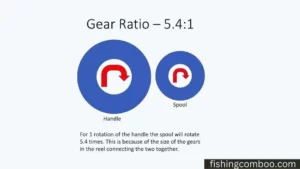
The gear ratio on a baitcaster dictates how much line is spooled with one turn of the handle. A higher gear ratio will result in more lines being spooled, while a lower gear ratio will result in fewer lines being spooled. There is no “correct” gear ratio, as it largely depends on personal preference and the type of fishing you’re doing.
If you’re using a bait-caster for the first time, it’s generally best to start with a lower gear ratio (5.1:1 or lower). This will give you more control over your casts and help you avoid backlash. Once you get more comfortable with using a bait caster, you can experiment with higher gear ratios.
To set the gear ratio on your baitcaster, turn the dial or lever (depending on the reel) to the desired setting. Most baitcasters will have markings or numbers that indicate the different gear ratios.
-5.1:1 is a good all-around gear ratio for baitcasting
-6.4:1 is good for fishing in open water with lures that don’t weigh much
-7.1:1 is good for flipping and pitching
-8.1:1 is good for fishing faster-moving baits
6. Adjust the Brakes on the Reel
One of the great things about baitcasting reels is that they come with built-in brakes. These brakes are designed to prevent your lure from flying off the reel when you cast it.
To adjust the brakes on your reel, start by removing the spool cover. Then, locate the brake adjustment knob and turn it clockwise to tighten the brakes or counterclockwise to loosen them.
Once you’ve adjusted the brakes to your liking, replace the spool cover, and you’re ready to start fishing.
There’re 2 main types of Braking Systems for Baitcasters:
Centifigural Braking System
The centrifugal braking system is the most commonly used type of brake on a baitcaster. This type of brake uses centrifugal force to slow the spool down when it is spinning too fast. The brake is located on the side of the reel and has two settings: a high setting and a low setting. The high setting should be used when you are casting heavier lures, and the low setting should be used when you are casting lighter lures.
To adjust the centrifugal brake, first remove the spool from the reel. Then, locate the two screws on the side of the reel that control the brake. To increase the brake’s power, turn the screws clockwise. To decrease the brake’s power, turn the screws counterclockwise. Once you have the brake set to the desired power, replace the spool on the reel.
Magnetic Braking System
In baitcasting reels, magnetic brakes are one of the most popular brake systems. It uses magnets to slow down the spool spinning, preventing line backlash and bird’s nests. If you’re using a bait caster for the first time, it’s important to learn how to adjust the magnetic brakes, so they’re not too loose or too tight.
Here’s a step-by-step guide on how to use a baitcaster with a magnetic braking system:
- Start by adjusting the dial on the side of the reel. This controls how much brake pressure is applied to the spool. You’ll get line backlash and bird’s nests if you turn it too loose. If you turn it too tight, the spool will spin too slowly, and you won’t be able to cast your lure very far.
- After you’ve adjusted the cast control knob to your liking, you can start fishing!
- Casting with a bait-caster is just like casting with a spinning reel. Having more control over where your lure goes is the only difference.
- If you get line backlash or bird’s nests, don’t worry! It happens to everyone when they first learn how to use a bait caster. Just stop spinning the reel and let the line out slowly until the tangle is gone. Then try again, and be sure to adjust the brakes if necessary.
With a little practice, it won’t take long for you to become a pro at casting!
How to Set Up a Baitcaster Rod?
If you’re new to baitcasting, the process of setting up your rod can seem a bit daunting. You don’t need to worry – we’ll guide you through the process.
First things first: you’ll need to assemble your baitcaster rod. Begin by attaching the reel to the rod – most baitcasting rods will have a reel seat, making this process easy. Thread the line through the guides after you’ve placed the reel. The line should be fed into the tip guide first, then worked down the rod to the reel.
When your line is in place, it’s time to attach your lure or bait. If you’re using a lure, simply tie it to the end of the line. If you’re using bait, you’ll need to attach it to a hook first. After you’ve placed your lure or bait, you’re ready to cast.
After setting up your reel and rod successfully, it’s time to cast. Just follow the simple and easiest steps below to cast a baitcaster.
Read our Detailed Guide on What are the Best Baitcaster Combos
How to Cast a Baitcaster – Tips and Tricks
- To cast your baitcaster, hold the rod in your dominant hand with your thumb on top of the reel. Position the rod, so the tip points towards the ground at a 45-degree angle. Place your other hand on the line above the reel, around 6 to 12 inches from the rod’s tip.
- Now, release your thumb from the reel and use your index finger to push down on the spool release button. As you do this, use your other hand to release the line from your grip and allow it to fall freely through the guides.
- With the line now released, quickly bring the rod tip up towards the sky in a smooth and fluid motion. As you bring the rod tip up, the line will begin to come off the reel and will start to travel through the guides.
- Once the rod tip reaches the 12 o’clock position, stop the forward momentum of the rod by abruptly snapping your wrist. As you do this, allow your thumb to come off the spool release button and quickly grab hold of the spool with your thumb.
- Doing this will cause the bait to be hurled forward and will also help to prevent the line from getting tangled.
Now, all you have to do is reel in your line and enjoy the fruits of your labour.
Additional Tips for Casting a Baitcaster
- Never force the line off the spool, as this can tangle the line.
- If you are using a braided line, be sure to use a smooth and fluid motion when casting, as this will help to prevent the line from getting tangled.
- If you are using a monofilament line, be sure to use a slower and more controlled motion when casting, as this will help to prevent the line from getting tangled.
- If you are using a fluorocarbon line, be sure to use a slower and more controlled motion when casting, as this will help to prevent the line from getting tangled.
- Always keep your thumb on the reel’s spool at all times while casting, as this will help prevent the line from getting tangled.
- If you are using a baitcaster for the first time, it is always a good idea to practice in an open area before using it in a confined space.
Advantages of Using Baitcasters
- Baitcasters are great for fishing in open water with few obstacles.
- Baitcasting reels are also good for fishing in heavy cover, where you need to make precision casts.
- Baitcasters are more accurate than spinning reels because the spool rotates around the fixed axis of the reel. This means that the line comes off the spool in a more controlled manner, resulting in fewer backlashes.
- Baitcasting reels are also easier to use when fishing with live bait, as you can control the speed of the bait better.
- Baitcasters require less effort to cast than spinning reels, as you only need to use your thumb to control the spool.
Disadvantages of Using Baitcasters
- Baitcasters are not the easiest type of reel to use
- Getting used to them can be challenging
- There is a learning curve associated with baitcasters
If you are new to fishing or have never used a baitcaster before, you may want to consider using another type of reel. Baitcasters can be difficult to use, and they can be difficult to get used to. There is a learning curve associated with baitcasters, so if you are not willing to spend time learning how to use one, you may want to consider using another type of reel.
If you are determined to use a baitcaster, then there are a few things that you can do to make the process easier.
First, you should practice casting in your backyard or in an empty field. I’m sure you’ll be able to understand how the reel works after completing this exercise.
Second, you should start off using lighter lures and lines. This will help you get a feel for the reel and how it works before you start using heavier lures and lines.
Finally, you should read the instructions that come with your reel carefully. With this technique, you’ll learn how to use a baitcaster for the first time and how it works.
If you use these recommendations, a baitcaster should be simple for you to operate. However, if you still have trouble, you may consider using another type of reel. Baitcasters are not for everyone, and if you’re not willing to take the time to learn how to use one, you may want to consider using another type of reel.
My Review About Baitcasters

I use baitcasters and found them much easier to use than a traditional spinning reel. You will definitely feel the difference in casting performance, but it took some time for me to get used to baitcasting. If you’re looking for an upgrade from your spinning reel, give a baitcasting reel a try.
You can read our detailed guide if you are searching for the best baitcaster combo.
Frequently Asked Questions (FAq’s)
How hard is it to learn to use a baitcaster?
Answer: While it’s not complicated to use a bait caster, it does require some practice. The main thing to remember is to keep your hands relaxed and let the spool do the work. Also, be sure to adjust the brakes (or drag) so that the line doesn’t overrun when you reel in. And finally, always practice in an open area where there’s no danger of getting your line caught in trees or other obstacles.
Are Baitcasters good for beginners?
Answer: Yes, bait casters are good for beginners. In fact, baitcasters are often recommended for beginners because they provide more control over the lure than do other types of reels.
Baitcasters have a centrifugal brake system that slows the spool down as it rotates faster than the line exiting the spool. This system provides more control over the lure and makes it easier to make subtle adjustments when casting. Additionally, baitcasting reels have a heavier weight, allowing them to cast farther than other types of reels.
How do you throw a baitcaster without backlash?
Answer: If you follow these steps, you can avoid most backlash when using a baitcaster. First, ensure that you’re using the correct weight for the lure you’re casting; too much weight will cause the lure to cast too far and result in backlash.
Second, use a slower reeling speed when bringing your lure back in; if you reel too quickly, it will cause the spool to spin faster than the line can handle, which will lead to a backlash. Finally, ensure that your reels are properly spooled and that your lines are free of knots or tangles.
Conclusion
Hope you’ve enjoyed our pro-level guide on how to use baitcaster for the fist time. Overall, bait casters are a great option for those looking to get into fishing or those who want to improve their casting. They provide more accuracy and distance than other types of reels and can be used in a variety of fishing situations. While they have some disadvantages, such as the need for more practice to use them effectively, these can generally be overcome with time and patience. Have you tried using baitcasters before? What was your experience like? Please let me know by commenting below.



